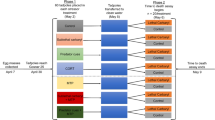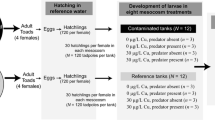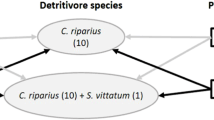Abstract
In addition to natural stressors such as predation risk, aquatic organisms receive the simultaneous impact of anthropogenic stressors like pollution. In order to advance our understanding of multiple stressor effects, we evaluated the potential costs in the population growth rate derived from the sub-lethal effect of exposure to the pesticide methamidophos and from the expression of morphological defenses front to predation risk, in the rotifer Brachionus calyciflorus. Costs were evaluated both in the organisms that were exposed to the stressors and in their offspring. Our hypotheses were (1) plastic morphological defenses under exposure to pesticides have fitness costs, which may be transmitted from the parental to the filial generation, and (2) interactive effects between pesticides and predation are dependent of the mother’s age. Our results indicate that pesticide exposure increased the costs, expressed as reduction in population growth rate, generated by the induction of defenses. Interestingly, these costs were detected only in the offspring of the treated organisms and were depended on the age of the mother. This indicates that the sub-lethal effects of predation were increased by pesticide pollution. This study provides experimental evidence of the transgenerational costs of phenotypic plasticity linked to interaction of natural and anthropic stressors.





Similar content being viewed by others
References
Agrawal, A. A., C. Laforsch & R. Tollrian, 1999. Transgenerational induction of defenses in animals and plants. Nature 401: 60–63.
Altshuler, I., B. Demiri, S. Xu, A. Constantin, N. D. Yan & M. E. Cristescu, 2011. An integrated multi-disciplinary approach for studying multiple stressors in freshwater ecosystems: Daphnia as a model organism. Integrative and Comparative Biology 51: 623–633.
Altshuler, I., A. M. McLeod, J. K. Colbourne, N. D. Yan & M. E. Cristescu, 2015. Synergistic interactions of biotic and abiotic environmental stressors on gene expression. Genome 58: 99–109.
Alvarado-Flores, J., R. Rico-Martínez, A. Adabache-Ortíz & M. Silva-Briano, 2015. Morphological alterations in the freshwater rotifer Brachionus calyciflorus Pallas 1766 (Rotifera: Monogononta) caused by Vinclozolin chronic exposure. Ecotoxicology 24: 915–925.
APHA, AWWA, WEF, 2012. Standard Methods for the Examination of Water and Wastewaters, 22th ed. American Public Health Association, Washigton D.C
Aránguiz-Acuña, A., R. Ramos-Jiliberto, S. Nandini, S. S. S. Sarma, R. O. Bustamante & V. Toledo, 2010. Benefits, costs and reactivity of inducible defences: an experimental test with rotifers. Freshwater Biology 55: 2114–2122.
Aránguiz-Acuña, A., R. Ramos-Jiliberto & R. O. Bustamante, 2011a. Experimental evidence that induced defenses promote coexistence of zooplanktonic populations. Journal of Plankton Research 33: 469–477.
Aránguiz-Acuña, A., R. Ramos-Jiliberto & R. O. Bustamante, 2011b. Experimental assessment of interaction costs of inducible defenses in plankton. Journal of Plankton Research 33: 1445–1454.
Aránguiz-Acuña, A. & R. Ramos- Jiliberto, 2014. Diapause may promote coexistence of zooplankton competitors. Journal of Plankton Research 36: 978–988.
Armengol, X., L. Boronat, A. Camacho & W. A. Wurtsbaugh, 2001. Grazing by a dominant rotifer Conochilus unicornis Rousselet in a mountain lake: in situ measurements with synthetic microspheres. Hydrobiologia 446(447): 107–114.
Barry, J. M., 1998. Endosulfan-enhanced crest induction in Daphnia longicephala: evidence for cholinergic innervation of kairomone receptors. Journal of Plankton Research 20: 1219–1231.
Beckerman, A., T. G. Benton, E. Ranta, V. Kaitalac & P. Lundbergd, 2002. Population dynamic consequences of delayed life-history effects. Trends in Ecology and Evolution 17: 263–269.
Benard, M. F., 2004. Predator-induced phenotypic plasticity in organisms with complex life histories. Annual Review in Ecology and Evolution System 35: 651–673.
Bendis, R. J. & R. A. Relyea, 2016. If you see one, have you seen them all?: community-wide effects of insecticide cross-resistance in zooplankton populations near and far from agriculture. Environmental Pollution 215: 234–246.
Biondi, A., L. Zappala, J. D. Stark & N. Desneux, 2013. Do biopesticides affect the demographic traits of a parasitoid wasp and its biocontrol services through sublethal effects? PLoS ONE 8: e76548.
Borowitzka, M. A. & L. J. Borowitzka, 1988. Micro-Algal Biotechnology. Cambridge University Press, Cambridge.
Caswell, H., 2001. Matrix Population Models: Construction, Analysis, and Interpretation, 2nd ed. Sinauer Associates Inc, Sunderland.
Christensen, M. R., M. D. Graham, R. D. Vinebrooke, D. L. Findlay, M. J. Paterson & M. A. Turner, 2006. Multiple anthropogenic stressors cause ecological surprises in boreal lakes. Global Change Biology 12: 2316–2322.
Coors, A. & L. De Meester, 2008. Synergistic, antagonistic and additive effects of multiple stressors: predation threat, parasitism and pesticide exposure in Daphnia magna. Journal of Applied Ecology 45: 1820–1828.
Dahms, H. U., A. Hagiwara & J.-S. Lee, 2011. Ecotoxicology, ecophysiology, and mechanistic studies with rotifers. Aquatic Toxicology 101: 1–12.
DeMille, C. M., S. E. Arnott & G. G. Pyle, 2016. Variation in copper effects on kairomone-mediated responses in Daphnia pulicaria. Ecotoxicology and Environmental Safety 126: 264–272.
Fernández-González, M. A., J. González-Barrientos, M. J. Carter & R. Ramos-Jiliberto, 2011. Parent-to-offspring transfer of sublethal effects of copper exposure: metabolic rate and life-history traits of Daphnia. Revista Chilena de Historia Natural 84: 195–201.
Forbes, V. & P. Calow, 1999. Is the per capita rate of increase a good measure of population-level effects in ecotoxicology? Environmental Toxicology and Chemistry 18: 1544–1556.
Garay-Narváez, L. & R. Ramos-Jiliberto, 2009. Induced defenses within food webs: the role of community trade-offs, delayed responses, and defense specificity. Ecological Complexity 6: 383–391.
Gilbert, J. J., 2009. Predator-specific inducible defenses in the rotifer Keratella tropica. Freshwater Biology 54: 1933–1946.
Gilbert, J. J., 2012. Predator-induced defense in rotifers: developmental lags for morph transformations, and effect on population growth. Aquatic Ecology 46: 475–486.
Gilbert, J. J., 2013. The cost of predator-induced morphological defense in rotifers: experimental studies and synthesis. Journal of Plankton Research 35: 461–472.
Gilbert, J. J. & M. C. Diéguez, 2010. Low crowding threshold for induction of sexual reproduction and diapause in a Patagonian rotifer. Freshwater Biology 55: 1705–1718.
Gilbert, J. J. & T. Schröder, 2003. The ciliate epibiont Epistylis pygmaeum: selection for zooplankton hosts, reproduction and effect on two rotifers. Freshwater Biology 48: 878–893.
Gilbert, J. J. & T. Schröder, 2007. Intraclonal variation in propensity for mixis in several rotifers: variation among females and with maternal age. Hydrobiologia 593: 121–128.
Giron, D. & J. Casas, 2003. Mothers reduce egg provisioning with age. Ecology Letters 6: 273–277.
Guo, R., X. Ren & H. Ren, 2012a. Assessment the toxic effects of dimethoate to rotifer using swimming behavior. Bulletin of Environmental Contamination and Toxicology 89: 568–571.
Guo, R., X. Ren & H. Ren, 2012b. Effects of dimethoate on rotifer Brachionus calyciflorus using multigeneration toxicity tests. Journal of Environmental Science and Health, Part B 47: 883–890.
Hamedi, N., Y. Fathipour & M. Saber, 2011. Sublethal effects of abamectin on the biological performance of the predatory mite, Phytoseius plumifer (Canestrini and Fanzago) (Acari: Phytoseiidae). Experimental Applied Acarology 53: 29–40.
Hanazato, T., 2001. Pesticide effects on freshwater zooplankton: an ecological perspective. Environmental Pollution 112: 1–10.
Harvell, D. C., 1990. The ecology and evolution of inducible defenses. Quarterly Review of Biology 65: 323–340.
Hussain, M. A., 1987. Anticholinesterase properties of methamidophos and acephate in insects and mammals. Bulletin of Environmental Contamination and Toxicology 38: 131–138.
Ibrahim, Y. B. & T. S. Yee, 2000. Influence of sublethal exposure to abamectin on the biological performance of Neoseiulus longispinosus (Acari: Phytoseiidae). Journal of Economic Entomology 93: 1085–1089.
Jamieson, C. D. & B. Santer, 2003. Maternal aging in the univoltine freshwater copepod Cyclops kolensis: variation in egg sizes, egg development times, and naupliar development times. Hydrobiologia 510: 75–81.
Janssens, L. & R. Stoks, 2013. Predation risk causes oxidative damage in prey. Biology Letters 9: 20130350.
Lampert, W., 1987. Predictability in lake ecosystems: the role of biotic interactions. In Schulze, E. D. & H. Zwölfer (eds), Potential and Limitations of Ecosystem Analysis. Springer-Verlag, Berlin: 333–346.
Lampert, W., K. O. Rothhaupt & E. von Elert, 1994. Chemical induction of colony formation in a green alga (Scenedesmus acutus) by grazers (Daphnia). Limnology and Oceanography 39: 1543–1550.
Lima, S. L., 1998. Nonlethal effects in the ecology of predator–prey interactions. Bioscience 48: 25–34.
Lin, K., S. Zhou, C. Xu & W. Liu, 2006. Enantiomeric resolution and biotoxicity of methamidophos. Journal of Agricultural and Food Chemistry 54: 8134–8138.
Lo, E., 2005. Gaussian error propagation applied to ecological data: post-ice-storm-downed woody biomass. Ecological Monographs 75: 451–466.
Ma, Q., Y. L. Xi, J. Y. Zhang, X. L. Wen & X. L. Xiang, 2010. Differences in life table demography among eight geographic populations of Brachionus calyciflorus (Rotifera) from China. Limnologica-Ecology and Management of Inland Waters 40: 16–22.
Malate, S., J. Blanco, C. Richter, B. Milow & M. I. Maldonado, 1999. Solar photocatalytic mineralization of commercial pesticides: methamidophos. Chemosphere 38: 1145–1156.
Manly, B. F., 2006. Randomization, Bootstrap and Monte Carlo methods in biology, 3rd ed. Chapman and Hall, London.
Marcial, H. S. & A. Hagiwara, 2007. Effect of diazinon on life stages and resting egg hatchability of rotifer Brachionus plicatilis. Hydrobiologia 593: 219–225.
Marshall, D. J., 2008. Transgenerational plasticity in the sea: context dependent maternal effects across the life history. Ecology 89: 418–427.
Martínez-Jerónimo, F. & G. Muñoz-Mejía, 2007. Evaluation of the sensitivity of three cladoceran species widely distributed in Mexico to three reference toxicants. Journal of Environmental Science and Health Part A 42: 1417–1424.
Moran, D. T., G. M. Dias & D. J. Marshall, 2010. Associated costs and benefits of a defended phenotype across multiple environments. Functional Ecology 24: 1299–1305.
Newman, M. C., 2001. Uptake, biotransformation, detoxification, elimination and accumulation. In Newman, M. C. (ed.), Fundamentals of Ecotoxicology. CRC Press, Florida: 25–49.
Opit, G. P. & J. E. Throne, 2007. Influence of maternal age on the fitness of progeny in the rice Weevil, Sitophilus oryzae (Coleoptera: Curculionidae). Environmental Entomology 36: 83–89.
Pestana, J. L. T., S. Loureiro, D. J. Baird & A. M. V. M. Soares, 2010. Pesticide exposure and inducible antipredator responses in the zooplankton grazer, Daphnia magna Straus. Chemosphere 78: 241–248.
Pope, C., S. Karanth & J. Liu, 2005. Pharmacology and toxicology of cholinesterase inhibitors: uses and misuses of a common mechanism of action. Environmental Toxicology and Pharmacology 19: 433–446.
Preston, B. L., G. Cecchine & T. W. Snell, 1999. Effects of pentachlorophenol on predator avoidance behavior of the rotifer Brachionus calyciflorus. Aquatic Toxicology 44: 201–212.
Rainieri, M., 1984. Histochemical investigations of Rotifera Bdelloidea. I. localization of cholinesterase activity. Histochemical Journal 16: 601–616.
Ramos-Jiliberto, R. & A. Aránguiz-Acuña, 2013. Bidimensional transfer of effects among organisms: an overlooked concept in community ecology. Revista Chilena de Historia Natural 86: 15–20.
Relyea, R. A., 2002. Costs of phenotypic plasticity. American Natuarlist 159: 272–282.
Relyea, R. A., 2005. The impact of insecticides and herbicides on the biodiversity and productivity of aquatic communities. Ecological Applications 15: 618–627.
Relyea, R. A., 2012. New effects of roundup on amphibians: predators reduce herbicide mortality; herbicides induce antipredator morphology. Ecological Applications 22: 634–647.
Relyea, R. A. & N. Mills, 2001. Predator-induced stress makes the pesticide carbaryl more deadly to gray treefrog tadpoles. Proceedings of the National Academy of Sciences of the United States of America 98: 2491–2496.
Relyea, R. & J. Hoverman, 2006. Assessing the ecology in ecotoxicology: a review and synthesis in freshwater systems. Ecology Letters 9: 1157–1171.
Riessen, H. P., 2012. Costs of predator-induced morphological defences in Daphnia. Freshwater Biology 57: 1422–1433.
Riessen, H. P., R. D. Linley, I. Altshuler, M. Rabus, T. Söllradl, H. Clausen-Schaumann, C. Laforsch & N. D. Yan, 2012. Changes in water chemistry can disable plankton prey defenses. Proceedings of National Academy of Sciences 109: 15377–15382.
Sakamoto, M., K. H. Chang & T. Hanazato, 2006. Inhibition of development of anti-predator morphology in the small cladoceran Bosmina by an insecticide: impact of an anthropogenic chemical on prey-predator interactions. Freshwater Biology 51: 1974–1983.
Schröder, T. & J. J. Gilbert, 2009. Maternal age and spine development in the rotifer Brachionus calyciflorus: increase of spine length with birth orders. Freshwater Biology 54: 1054–1065.
Schulz, R., 2004. Exposure, effects, and risk mitigation of insecticide pollution. Journal of Environmental Quality 33: 419–448.
Serra, M. & C. E. King, 1999. Optimal rates of bisexual reproduction in cyclical parthenogens with density-dependent growth. Journal of Evolutionary Biology 12: 263–271.
Serra, M., T. W. Snell & C. E. King, 2004. The timing of sex in cyclically parthenogenetic rotifers. In Moya, A. & E. Font (eds), Evolution from Molecules to Ecosystems. Oxford University Press, Oxford: 135–146.
Snell, T. W., 1987. Sex, population dynamics and resting eggs production in rotifers. Hydrobiologia 144: 105–111.
Snell, T. W. & C. Joaquim-Justo, 2007. Workshop on rotifers in ecotoxicology. Hydrobiologia 593: 227–232.
Snell, T. W. & B. D. Moffat, 1992. A 2-d life cycle test with the rotifer Brachionus calyciflorus. Environmental Toxicology and Chemistry 11: 1249–1257.
Southwood, T. R. E. & P. A. Henderson, 2000. Ecological methods, 3rd ed. Blackwell Sciences, Oxford.
Stemberger, R. S., 1981. A general approach to the culture of planktonic rotifers. Canadian Journal of Fisheries and Aquatic Sciences 38: 721–724.
Stemberger, R. S., 1988. Reproductive costs and hydrodynamic benefits of chemically induced defenses in Keratella testudo. Limnology and Oceanography 33: 593–606.
Stemberger, R. S., 1990. Food limitation, spination, and reproduction in Brachionus calyciflorus. Limnology and Oceanography 35: 33–44.
Tien, C.-J. & C. S. Chen, 2012. Assessing the toxicity of organophosphorous pesticides to indigenous algae with implication for their ecotoxicological impact to aquatic ecosystems. Journal of Environmental Science and Health, Part B 47: 901–912.
Tollrian, R. & C. D. Harvell, 1999. The evolution of inducible defenses: current ideas. In Tollrian, R. & C. D. Harvell (eds), The Ecology and Evolution of Inducible Defenses. Princeton University Press, New Jersey: 306–321.
Tomlin, C., 1994. The Pesticide Manual, 10th ed. Royal Society of Chemistry, Cambridge.
Trekels, H., F. Van de Meutter & R. Stoks, 2013. Predator cues magnify effects of the pesticide endosulfan in water bugs in a multi-species test in outdoor containers. Aquatic Toxicology 138(139): 116–122.
Van Allen, B. G. & V. H. Rudolf, 2013. Ghosts of habitats past: environmental carry-over effects drive population dynamics in novel habitat. The American Naturalist 181(5): 596–608.
Van Buskirk, J., 2000. The costs of an inducible defense in anuran larvae. Ecology 81: 2813–2821.
Van der Stap, I., M. Vos & W. M. Mooij, 2007. Inducible defenses and rotifer food chain dynamics. Hydrobiologia 593: 103–110.
Van Straalen, N. M. & A. Hoffmann, 2000. Review of experimental evidence of physiological costs of tolerance to toxicants. In Kammenga, J. & R. Laskowski (eds), Demography in Ecotoxicology. Wiley, Chichester: 147–161.
Wallace, R. L. & H. A. Smith, 2009. Rotifera. In Likens, G. E. (ed.), Encyclopedia of Inland Waters. Elsevier, Oxford: 689–703.
Wallace, R. L., T. W. Snell, C. Ricci & T. Nogrady, 2006. Rotifera 1: Biology, Ecology and Systematics. Backhuys Publishers, Leiden.
Werner, E. E. & S. D. Peacor, 2003. A review of trait-mediated indirect interactions in ecological communities. Ecology 84: 1083–1100.
Acknowledgements
I.H.-F. acknowledges a Doctoral scholarship from Comisión Nacional de Investigación Científica y Tecnológica (CONICYT-PCHA/Doctorado Nacional/2015-211521). This study was supported by Fondo Nacional de Desarrollo Científico y Tecnológico grants: FONDECYT 1150348 to R.R.-J and FONDECYT 11130653 to A.A.-A. The authors thank Luis Valenzuela and Claudio Quezada for statistical assistance, and two anonymous reviewers for their helpful suggestions to an earlier version of the manuscript.
Author information
Authors and Affiliations
Corresponding author
Additional information
Handling editor: Diego Fontaneto
Electronic supplementary material
Below is the link to the electronic supplementary material.
Rights and permissions
About this article
Cite this article
Heine-Fuster, I., Aránguiz-Acuña, A. & Ramos-Jiliberto, R. Pesticide increases transgenerational cost of inducible defenses in a freshwater rotifer. Hydrobiologia 799, 249–260 (2017). https://doi.org/10.1007/s10750-017-3221-4
Received:
Revised:
Accepted:
Published:
Issue Date:
DOI: https://doi.org/10.1007/s10750-017-3221-4




